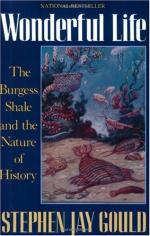
|
Chapter 1, The Iconography of an Explanation
1. What is the Burgess Shale?
(a) The smallest collection of fossils ever discovered.
(b) The Canadian Rockies.
(c) The largest collection of fossils ever discovered.
(d) A territory of British Columbia.
2. Who was America's "greatest paleontologist and scientific administrator"?
(a) Dr. Doolittle.
(b) Charlie VanGuarden.
(c) Charles Walmont.
(d) Charles Doolittle Walcott.
3. Who proposes to use the Burgess Shale to illustrate the nature of history?
(a) Mary J. Gold.
(b) Steven Kay Gold.
(c) Stephen Jay Gould.
(d) Marie Janine Gold.
4. According to Gould, what kind of insight does the Burgess Shale offer into the nature of life and the evolution of life forms?
(a) Weird insight.
(b) Unique insight.
(c) Distasteful insight.
(d) Normal insight.
5. Where is the Burgess Shale?
(a) The Appalachian Mountains.
(b) England.
(c) Mt. Everest.
(d) The Canadian Rockies.
6. What is the Burgess Shale composed of?
(a) Invertebrates.
(b) Viruses.
(c) Amoebas.
(d) Vertebrates.
7. What kind of lessons does Stephen Jay Gould draw from how the Burgess Shale was first interpreted?
(a) Religious and traditional lessons.
(b) Methodological and philosophical lessons.
(c) Conservative and biological lessons.
(d) Medieval and historical lessons.
(read all 180 Multiple Choice Questions and Answers)
|
This section contains 4,070 words (approx. 14 pages at 300 words per page) |

|




